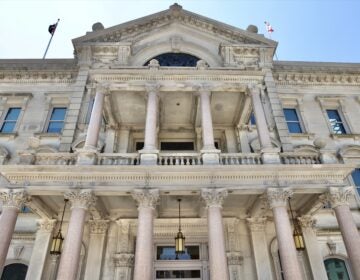Princeton photo exhibit reflects on the Pine Barrens
This is part of a series from Ilene Dube of The Artful Blogger.
New Jersey may be the most densely populated state, but it’s also home to the largest tract of undeveloped land between Florida and Maine. At 1.1 million acres and covering 1,875 miles, the New Jersey Pine Barrens occupies almost a quarter of the Garden State.
With 27 varieties of wild orchids, including Pink Lady’s Slipper, the Pines is habitat to 43 threatened or endangered animals.
Princeton native Richard Speedy, who has been photographing the region since the 1970s, likes that he can get there in just over an hour. It’s fitting that his large color prints are on view at Morven Museum & Garden, since Morven was the official governor’s residence in 1979 when Gov. Brendan Byrne issued an executive order resulting in preservation of the Pines.
On leaving office, Gov. Byrne said it was preservation of the Pinelands he most wanted to be remembered for.
On Sunday, March 3, former Governors Brendan Byrne and Jim Florio, Pulitzer Prize-winning author John McPhee, Michele Byers of New Jersey Conservation Foundation, and Carleton Montgomery of Pinelands Preservation Alliance will discuss the past, present and future of the Pine Barrens at Princeton University, as part of the exhibit The Pine Barrens: A Legacy of Preservation | Photographs by Richard Speedy at Morven through April 14.
Until he read McPhee’s 1968 book, Gov. Byrne didn’t know much about the Pines. The Pine Barrens not only called attention to the natural treasure, but dispelled misunderstandings about the region’s people.
“Pineys” – a derogatory term for those who lived in the Pines – led a hardscrabble existence off land that offered little. A 1913 article painted a grim picture of these families, according to Morven Curator of Collections and Exhibitions Elizabeth Allan. The “negative article told stories of generations of illiteracy and degeneracy. This led to decades of misconceptions regarding the often quiet, resourceful, and hardworking people of the Pine Barrens.”
Speedy’s large color photos focus more on the land than the people. Through his lens we see a winding cracked-earth road leading into the tall pines and mossy understory; ice designs with bubbles and leaves; mist rising above scrubby trees and bright orange “coins” – round leaves floating on the waterway.
He’s there in autumn, when the foliage is copper colored, and he’s back again for “Winter Morning – Chatsworth,” a color print that is mostly black and white with a haze of color in the distant tree canopy. In “Bog Reflection” the water is teeming with life, from sprouting grasses and lily pads to decaying wood, providing nutrients to new life.
European settlers named the Pine Barrens for the sandy nutrient-poor soil. Forty-five inches of annual rainfall drains rapidly through the acid soil, forming underground aquifers. The surface water is browned by iron deposits and tannins from leaf litter, and this in turn spawns an array of plant and animal life — so, ecologically, it is anything but barren.
Those tannins are what make the lakes look like they’ve been filled with an abundance of strong Camellia sinensis. No wonder the rufous-sided towhee sings “Drink your tea! Drink your tea!”
More than 200 years ago this space of wilderness was a landscape of industry. The Batsto River, rich with bog ore, was mined using flat-bottomed boats to build up the Batsto Iron Works. In the late 18th century, Batsto was well known for iron pots, Dutch ovens, cast iron pipes and pot-bellied stoves. By the mid 19th century, Pennsylvania was producing cheaper and better iron, so Batsto turned to making glass street lamp panes and windowpanes. The first Mason jar was blown in Batsto.
By 1874, a fire destroyed half the village.
Along came Joseph Wharton — a Quaker who made his fortune in nickel mining and founded the Wharton School at the University of Pennsylvania. Wharton bought the village and surrounding area and grew peanuts, salt hay and cranberries in the bogs that had once yielded iron. Wharton planted thousands of trees — black walnut, catalpa, cottonwood, white pine, Norway spruce and European larch. Today the trees make up Wharton State Forest, a State Historic Site.
Speedy, who lives and works out of the Chocolate Factory in Hopewell for half the year – the other half of the year he’s in Mexico – has been hiking, camping and making photographs since childhood, when his father was national director of Cub Scouting and program director for the Boy Scouts of America.
“The Pine Barrens is, for me, a sanctuary,” he says. “I learned years ago that I don’t have to head out west, up North or down to Mexico to find a place of peace, quiet, andnatural beauty.”
*The Pine Barrens: A Legacy of Preservation | Photographs by Richard Speedy is on view at Morven Museum & Garden, 55 Stockton St., Princeton, through April 14.
*”The Pine Barrens: The Past, the Politics, and the Future,” a panel discussion with Governors Brendan Byrne and Jim Florio, author John McPhee, Michele Byers of New Jersey Conservation Foundation, and Carleton Montgomery of Pinelands Preservation Alliance will be held at Princeton University, McCosh 50 Lecture Hall, March 3, 2 p.m. www.morven.org; 609-924-8144 x 113.
______________________________________________________
The Artful Blogger is written by Ilene Dube and offers a look inside the art world of the greater Princeton area. Ilene Dube is an award-winning arts writer and editor, as well as an artist, curator and activist for the arts.
WHYY is your source for fact-based, in-depth journalism and information. As a nonprofit organization, we rely on financial support from readers like you. Please give today.









